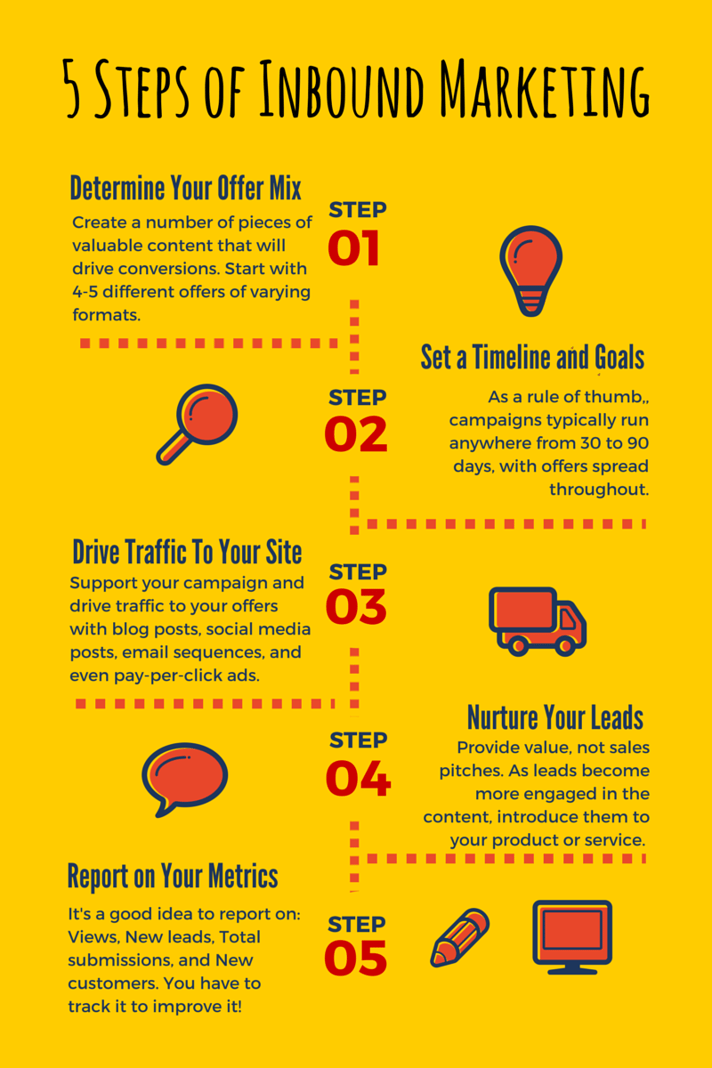Revisiting The Power Of An Inbound Marketing Strategy
As a business owner or marketer you have a number of marketing strategies to choose from. But not all marketing strategies are a good fit for every business. So how do you decide?

[This post was adapted and revised from a post published June 2016]
If you were to categorize marketing techniques, or strategies, from a simplified and high-level perspective you could reasonably say that there are two approaches. There is the traditional "outbound" approach and the less interruptive "inbound" approach.
You may have heard that inbound Marketing is the marketing strategy of the future, or something long those lines. Content marketing, while sometimes equated with inbound marketing, is more properly seen as the core function within an inbound marketing strategy. And it has been proven to be the most effective marketing approach for most any business.
In fact, marketing expert Seth Godin once famously said that,
“[Content Marketing] is all the marketing that’s left.”
Now that's a pretty big claim! And you might wonder if you can really benefit from using content to promote your company?
The Power of Content in Inbound Marketing
Whether you are publishing blog posts, white papers, or launch email campaign - your content works by attracting, engaging, and moving your audience. That is, providing your audience is made up of the right people for your service or product. In other words, quality leads or prospects.
The question, though, is does it really work?
Here are some revealing statistics illustrating the facts that drive inbound marketing success:
- Brands relying on inbound marketing save over $14 dollars for every new customer acquired. [www.stateofinbound.com]
- Leaders in using content marketing strategy see 700% more site traffic than non-leaders [www.kapost.com]
- Two thirds of B2B marketers say content is useful across all channels, including events, social, demand generation, etc. according to Kapost's Content Ideas research
- According to the 2015 IBM Digital Experience Survey, 56% of marketers believe that personalized content promotes higher engagement rates.
- Inbound marketing delivers 54% more leads into the marketing funnel than traditional outbound marketing. [www.stateofinbound.com ]
- Although content marketing costs at over 60% less than outbound marketing, it generates more than three times as many leads as outbound tactics.
- Adopting an inbound strategy doubles average website conversion rates, from 6% to 12% [www.stateofinbound.com ]
- For every $1 spent, email gives back a whopping $38 in ROI, and offers the broadest reach [www.campaignmonitor.com]
- You are six times more likely to get someone to click-through to your website via email than you are from Twitter.
- And, lastly, 4.24% of visitors from email marketing buy something as compared to 2.49% of visitors from search engines and just 0.59% from social media, according to Monetate.
Five Steps to Your Own Inbound Marketing Strategy
There is a lot of talk on social media and in the marketing world about creating content, business blogging, and so on. But is is often difficult to find clearly defined methods, strategies, and - most importantly - the real benefits of using content for inbound marketing.
But, as we've noted above, inbound marketing can far out-do more traditional outbound marketing tactics and Pay-per-click (PPC) advertising tactics - and for far less cost.
An inbound marketing campaign is a concentrated effort to attract leads and customers who are interested in a particular topic, or have a specific need. It is not a “sales” campaign, certainly not in the traditional sense, but the long term result is to get more sales.
But it’s in the execution of the campaign that the real difference between “traditional” marketing and “inbound” marketing becomes apparent. Inbound marketing campaigns have a number of components that require forethought, planning and orchestration.
So whether you're thinking of your first campaign or just want to review the basics, this simple, 5-step process to execute your next inbound marketing campaign will help.While there are a number of elements involved for each step, a quick overview would look like this:
Step 1: Determine Your Offer Mix
Inbound marketing campaigns are based on creating an effective mix of offers, or content. The objective is to create a number of valuable content pieces that you think will drive traffic and eventually create conversions Starting with around 4-5 different offers of varying formats is a good strategy, but remember that this can always be increased if needed.
Step 2: Set a Timeline and Goals
The timeline will be different for each campaign and is tied directly to your campaign goals. Think about how to spread out your different offers to maximize their impact without having them run so long that the overall theme is diluted. As a rule of thumb, campaigns typically run anywhere from 30 to 90 days, with your offers spread strategically throughout the timeline of the campaign.
Step 3: Drive Traffic
To support your campaign and drive traffic to your offers, give the rest of your communication channels an effective and strategic push for your campaign:
- Blog Posts: Dedicate a percentage of your blog posts to the topic your campaign covers.
- Social Media: Post offers to your social media channels, and join existing conversations on other blogs and forums.
- Email Series: Launch some of your offers with an introductory email. Segment your list to include people who are most likely to be interested in the content – don’t just blast a general email to everyone.
Step 4: Nurture Your Leads
The Number One rule of inbound marketing is: “Provide value.” Inbound marketing is not the place for high-pressured sales pitches. Not everyone drawn into your campaign is ready to make a purchasing decision. Give your leads more and more information to nurture them through the sales funnel.
As your lead becomes more engaged in the content and opts to download additional offers, start to introduce them to your product or service. If they aren’t interested, don’t push a sales call on them. If they do continue to click through on your emails and convert on your offers, they may be ready to hear more.
Step 5: Track and Report Your Metrics
There are a few metrics that are critical to measuring the success your campaign. When you bring your campaign to a close, you should be able to report on the following items:
- Views: Measuring the number of views will give you a sense of how effective your promotion was. If your views were low, you will know to evaluate and improve your promotion channels and strategy.
- New Leads: New leads are critical to your sales team and are an indicator that you're tapping into a market or segment, and that your content was effective in attracting people to your company.
- Total Submissions: Form submissions are critical. They are another type of engagement and they reveal of what your leads are interested in.
- New Customers: The number of new customers is certainly an important metric, but you often can't measure this fully until some time has passed. It is valuable, too, to measure which campaigns brought in actual customers or just more leads.
Picturing A Basic Inbound Marketing Strategy
Here is a basic overview of the process visualized in an infographic:

An inbound marketing campaign can be as simple as three or four content pieces and a strategy spread out over three weeks, or as complex as a multiple-piece campaign involving numerous landing pages, email strategies and a four-to-six month timeline.
Or anything in between.
Either way, the strategy all comes down to these five simple steps!
Getting Help With Your Inbound Marketing
The approach of inbound marketing holds great promise for your business. But achieving your marketing objectives with a content marketing strategy takes time. It won't happen with a few blog posts or great ebook. People will need to consume your content for a while before they contact you. Yet, without your content compelling them to contact you, your goals may never be met.
The good news is that you don't have to figure out alone. In fact, one of the best investments you can make with your marketing budget is to partner with a solid firm like BroadVision marketing. Click here to get your free Complimentary Inbound Marketing Session so you can make an informed decision, or call BroadVision Marketing at 707-799-1238. And be sure to download our "10 Powerful Inbound Marketing Charts"
You May Also Like
These Related Stories

5 Easy Steps To Inbound Marketing [Infographic]

5 Steps Of An Inbound Marketing Strategy [Infographic]





No Comments Yet
Let us know what you think